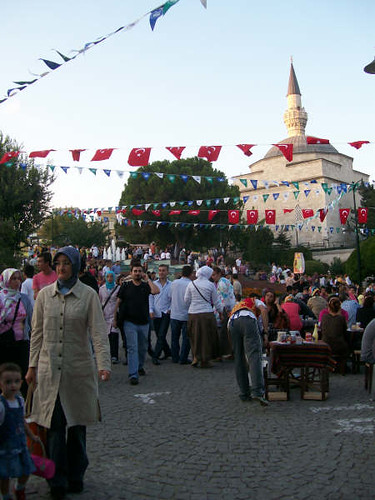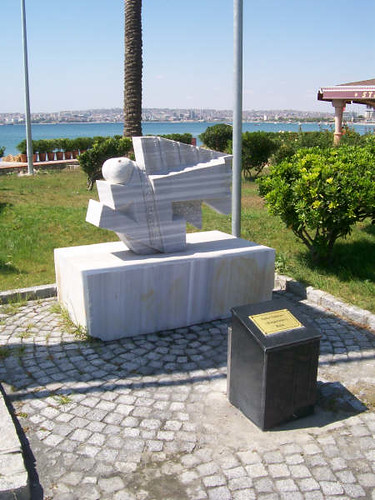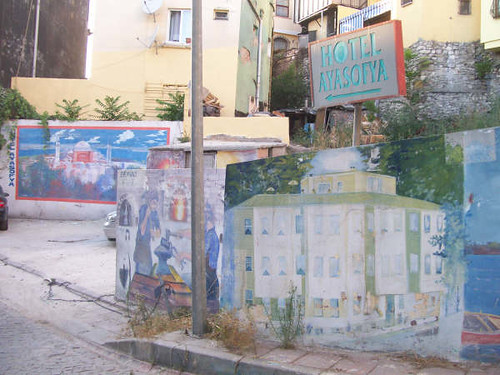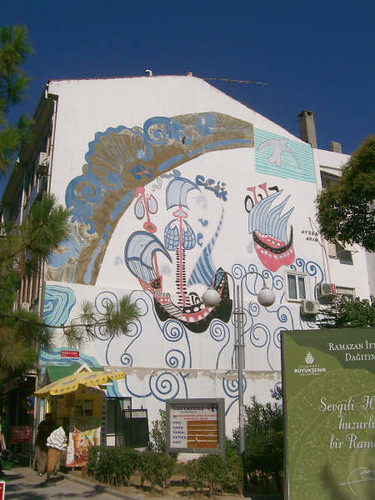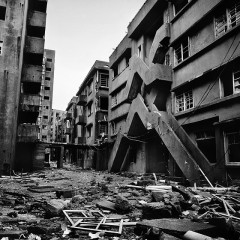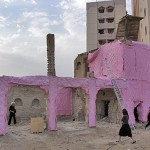Post by Marie H. Elcin
Istanbul is an overwhelming, sprawling city with over 12 million citizens, where the rich are very rich and the poor are very poor. As it is a modern metropolis, I had expected to find a hopping contemporary art center to rival New York, or at least Philadelphia, especially considering the recent rise of the Istanbul Biennial, the brand new Istanbul Modern Art Museum, and the city’s upcoming status as 2010 European Capital of Culture. I came away with mixed impressions, partly due to the quality of the work I saw, and partly because I was unable to view a wide selection of venues.
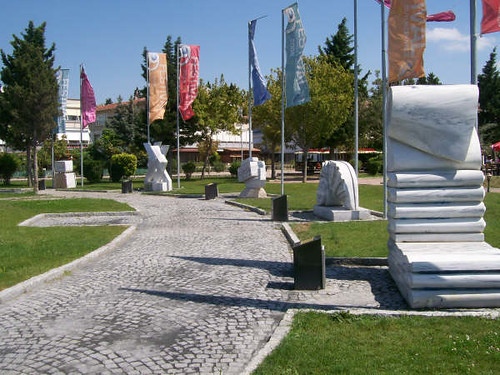
Buyukcekmece seaside sculpture garden, one of a series there.
There is no truly concentrated art district such as Old City, and a great deal of contemporary art is held in corporate collections. Turks in general do not seem to have an interest in Art- few homes display any paintings, and the walls are reserved for wedding photos and religious calligraphy. Their visual culture focuses on traditional crafts, fashion, and advertising. A lack of public art education and a difficult economic environment are major deterrants, but I also believe that a certain sense of Islamic iconoclasm prevents the full flourishing of a contemporary Turkish art scene. Hopefully 2010 will allow the city to establish a firmer presence of visual arts. Considering increasing consumerism in Turkey, it should not be hard to cultivate collectors.
The art:
After 2 hours of enduring stinky, crowded public transportation, Istanbul Modern appears an oasis of cool, clean quiet. A former shipping warehouse in Karakoy alongside the Bosporus Strait, Istanbul Modern started off as the site of the Istanbul Biennial. Five years ago it was quite raw–concrete and steel and kind of scary. Now it has more delineated spaces and better lighting.

Balkan Naci Islimyeli, Strait Jacket
The museum is dedicated to showing Turkish artists, but does invite international artists for temporary exhibitions (the museum was between exhibits on my visit).
One side of the main floor contains space for changing exhibitions, and I was delighted to see they’d allotted one room for each artist in their exhibit ‘Individual Expressions’. It was like a mini retrospective for each artist. Two artists stood out for me: Balkan Naci Islimyeli and Omer Uluc. Both seemed to push their materials and deeply explore their themes in a more committed way than any of the others. Islimyeli’s ‘Strait Jacket’ has 2 self-portrait silhouettes facing each other, and the black jacket area is covered in textured Arabic-like script. The jacket recalls those worn by Ottoman Sultans, which would be covered in Koranic script for protection. I appreciated his use of historical reference in a piece that seemed to be about a struggle over personal identity.
Omer Uluc caught my eye with a three-panel abstract painting on long pvc-carpets hung on the wall to create 3-dimensional ripples (visible on the Istanbul Modern website). It reminded me of the Sam Gilliam pieces in the Reverberations show at PAFA, trying to meld 2-D and 3-D, and using non-traditional materials.
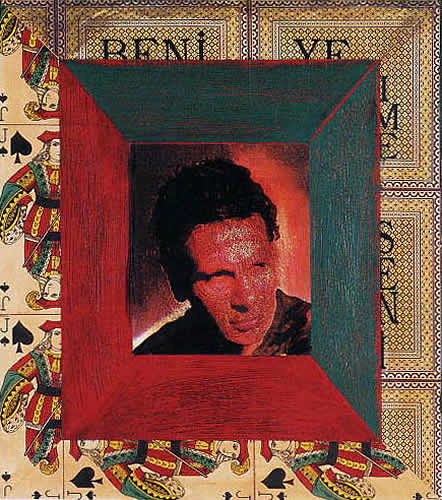
A small exhibition of Turkish Self-portraiture spanned a century of painters (all men alas) and included Ismet Dogan’s ‘Eat Me’, framed in Jokers. His use of card images as frames reminded me of the Gilbert and George show at the PMA, but his juxtaposition of images in another piece was distinctly exploring Turkish identity: Ottoman sultans vs. Ataturk, Arabic calligraphy vs. Latin italics, ancient architecture vs. modern maps.
Half of the museum is dedicated to a permanent exhibit of paintings that span the history of the Turkish republic. Much of the work up to the ’80s seems to parallel the European Masters (oh how they love Cezanne and Van Gogh!) It is not until the ’90s that the work starts to take on a unique flavor–that finally, after decades of trying to catch up to Western standards, they decided to make something their own. The best work finds a way to honor the rich cultural traditions of the Ottoman past without being restricted by them. Contemporary Turkish artists are treading the waters between East and West and Past and Present.
Public Art:
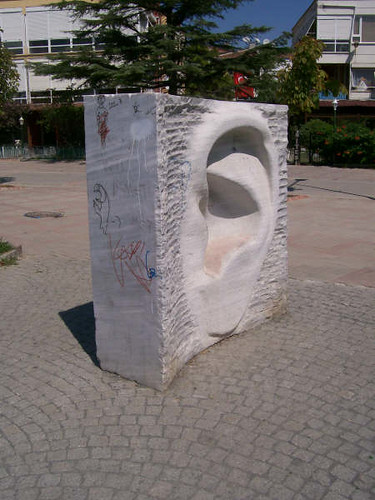
A sculpture covered with graffiti
There may not be a centralized art district, but each Belediyesi (municipality) within Istanbul makes an effort to have cultural offerings.
In Buyukcekmece, where I was staying, the municipality has connected with sister cities around the world, and has invited artists to participate in an annual arts festival. The result is a series of sculpture parks along the seaside. This year each artist worked in marble, and participants came from Turkey, Serbia, Lebanon, France, Belgium, Italy, Bulgaria, Greece, and Bolivia. Unfortunately, local youth have no respect for public art, and several sculptures have been covered with graffiti.
Murals:
I’m a Philly girl and I love my murals! I do not know of any organized effort in Istanbul to create murals, but I loved coming across them when I did. Many appear to have been authorized by individual municipalities, others look like a kind of advertising.
So although most Turks wouldn’t put art in their homes, they do seem to like it in their public spaces. Sculptors and foundries probably make out the best, as every official building and town square has a bas-relief, bust, or full size statue of Ataturk!
–Fiber artist and embroiderer extraordinaire Marie Elcin will be showing at the Random Tea Room Oct 9th-24 and in the window at the Art Shop at Moore in November.


